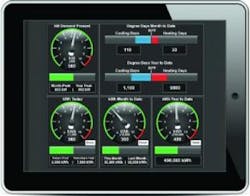Commercial buildings can realize numerous benefits from installing a building automation system (BAS), including improved facility performance and efficiency, optimized occupant comfort and easier day-to-day operation and control of the building and its system.
A BAS provides the ability to integrate multiple building systems such as heating, ventilation, and air conditioning (HVAC), lighting and security, so they can be controlled by one single interface for greater efficiency and optimized performance.
Ensuring that a BAS is optimized for a specific building and application — and that it continues to stay optimized after installation — is key to getting the most out of the investment.
Following a few tips and best practices can help mitigate some of the common issues that can arise with building automation, to help keep the system optimized for effective and efficient performance.
Setpoint Changes and System Overrides
One of the most common issues that can hamper efficient building performance is overrides that veer from the original setpoints and design intent of the building and systems.
When a user or building occupant (such as in an office building, for example) overrides a setpoint in the system and the system is not returned to the original setting, it can have a negative impact on other spaces in the building.
A BAS — which should be optimized at installation — can lose effectiveness over time if it isn’t properly maintained. People may not realize the impact that one simple override can have on the entire building or system. Fortunately, it’s typically easy to remedy issues that stem from overrides.
Security measures can help limit overrides and the ramifications they can have. These measures include PIN control on user access to system changes and the ability to program setpoint “traps,” such as a specific temperature range for a certain area, to restrict override changes from going outside of set parameters. Many systems also have a timed feature, to automatically revert to original settings after a temporary override period.
Mechanical Problems in the Building
A BAS can provide information or alerts that show when there is a mechanical problem in a building, but it typically cannot fix a mechanical problem. This makes it important to monitor system performance and look for anomalies, as issues in a building can also mask each other.
For example, ductwork is often among the last items installed in a building, and it may not be optimized for airflow and delivery to a certain space. A BAS may be programmed to do everything it can to efficiently get air to that space, but the ductwork design may hamper optimal airflow. Information from the BAS can alert to the fact that the space isn’t being properly cooled, but be aware that it may require a mechanical fix to correct the issue.
Many automation systems can run reports to look for issues. If a problem is noted, it’s important to look at all the original settings and any possible overrides on a piece of equipment to help determine what might be the cause.
Watch for Indicators
High energy bills and increased occupant complaints about abnormal temperatures are both good indicators that a BAS may not be performing optimally.
Increased occupant complaints about a certain space can be a sign of a setpoint override or of sensor wear. Sensors can wear over time and eventually fail, and occupant complaints are often the first indicator of this issue if a malfunctioning sensor is reporting incorrect information to the BAS. Typically the best course of action is to replace a failing sensor.
These indicators can also be a signal to check for setpoint overrides, which might be the cause of the problem.
Other Tips for Optimization
Ensuring that best practices are followed in BAS installation and setup also promotes continued optimized system performance. An example is following best practices for sensor placement. Sensors should not be placed near heat-generating equipment, in order to get the most accurate temperature readings.
New technologies and solutions for building controls and energy management can also help keep BAS performance optimized. One such technology is wireless communication. Using wireless technology for building controls offers flexibility in installation and easier troubleshooting, and wireless sensors can easily be moved to improve sensing accuracy or when building or space needs change.
BAS technology also enables the use of energy management solutions, providing features such as real-time monitoring of a building’s energy-related data, energy analytics and automated fault detection. This link to additional, proactive intelligent services makes it easier to monitor data and gain insights that help drive improvement efforts.
Realizing the Benefits
Being aware of the common issues that can arise with building automation — and knowing how to spot and fix these issues — can help maintain efficiency of the system, and reduce operating costs and occupant complaints.
The many benefits offered by building automation can result in easier, more efficient management of building systems. However, following best practices for managing and using the system plays a role in achieving optimized performance over the life of the system.
Sean Apsey is a Trane service account manager based in Columbus, Ohio, with 10 years of experience in the HVAC and controls industry. Apsey has a bachelor’s degree in HVAC engineering technology from Ferris State University.


